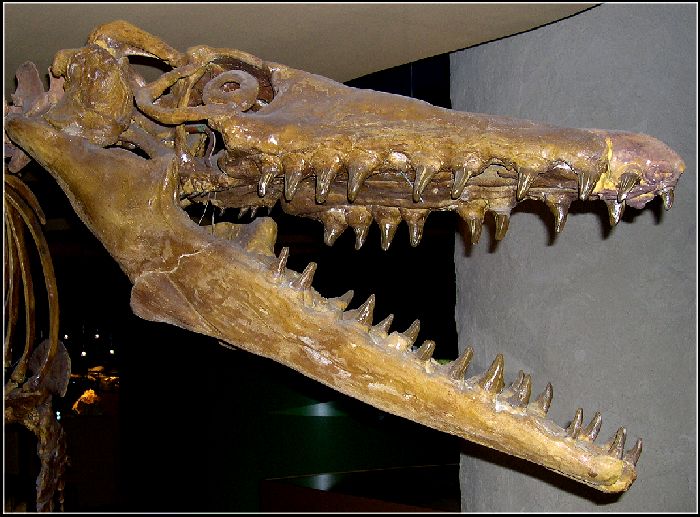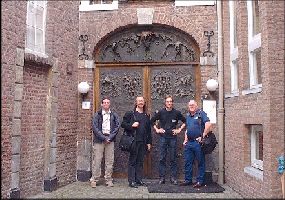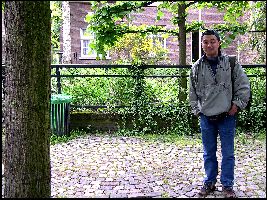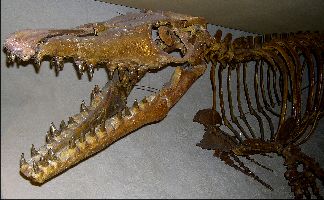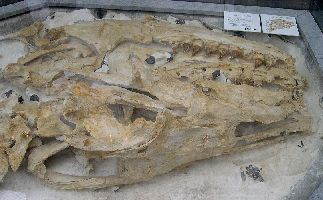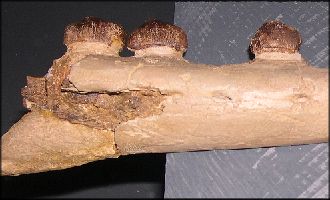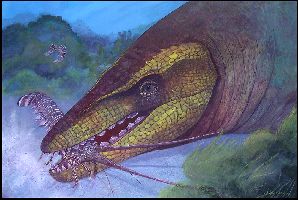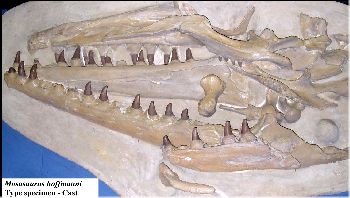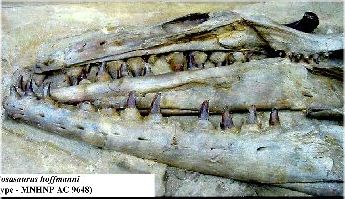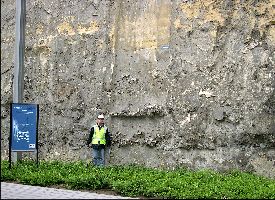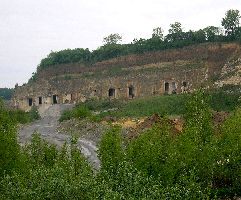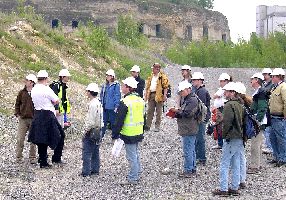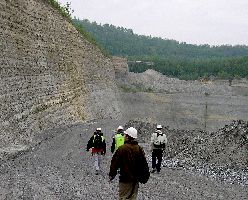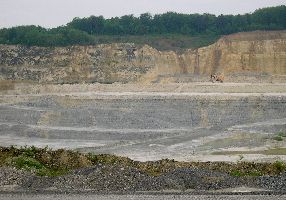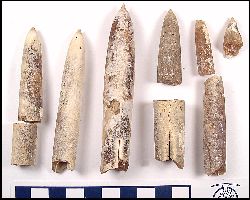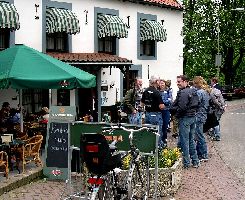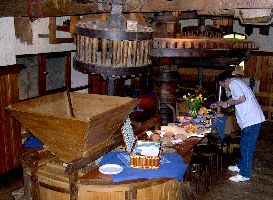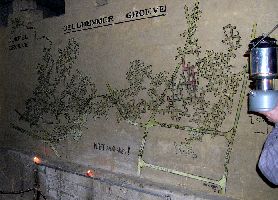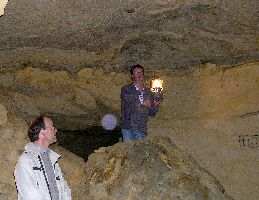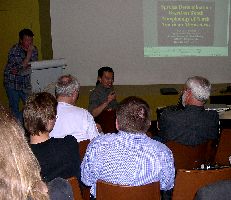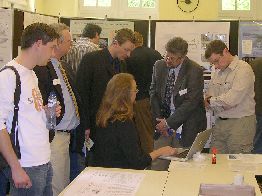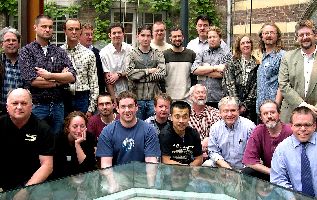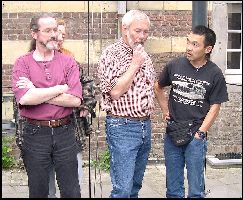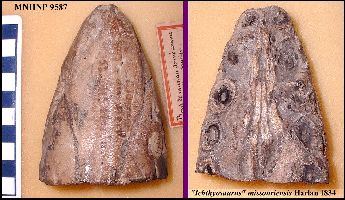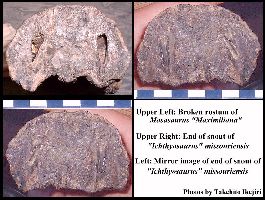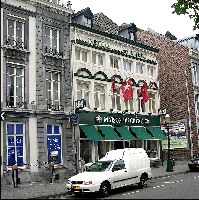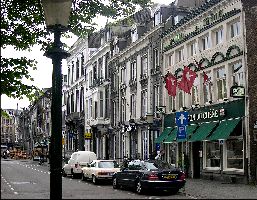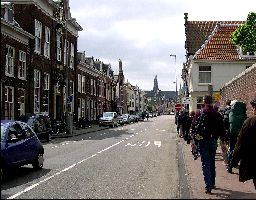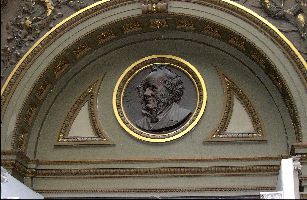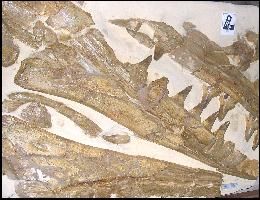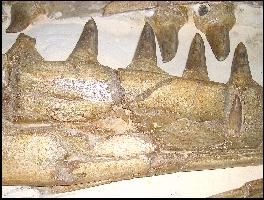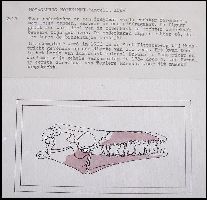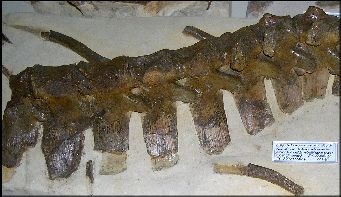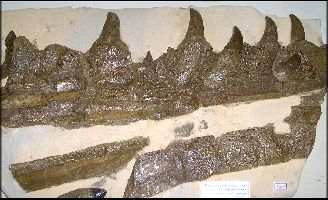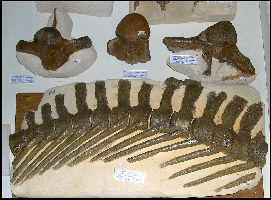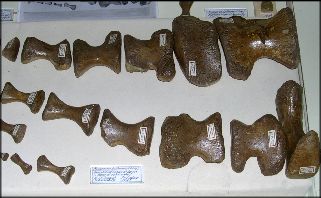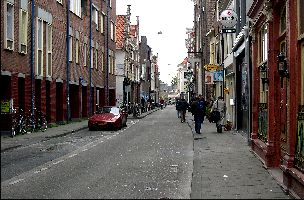My 2004 Trip to Maastricht - The First
Mosasaur Meeting Blog
Friday-Saturday, May 7-8:
Left Wichita on time, flying on a Northwest Airlines twin-jet by Bombardier.
Nice plane (new) and smooth flight. Arrived at the Minneapolis airport on time – long
walk from the gate to the terminal (G) where the international flights depart…
fortunately they had moving walkways all the way between the two terminals. I converted
$100 into 70 Euros… (including a $5 fee) which didn’t seem like a good trade to
me.. but I did not much choice in the matter. I’ll convert some more cash in
Amsterdam and see if there’s any difference. (actually found out that they also have
“Cirrus” ATMs in the Netherlands and there is no need to convert….)
The flight to Amsterdam loaded a bit early and left the gate
on time, but someone realized that they had put too much freight (overweight or out of
balance or something) on the plane. The pilot
announced that we were returning to the terminal to unload a pallet of cargo. It didn't take very long but we were still almost
45 minutes late getting off the ground. Once we were in the air, he announced we’d
arrive about 15 minutes late, so it looks like he’s planning on making up some time
along the way. We’re flying on a DC-10, and it’s apparently full. They had beverage service just after take-off and
turned right around and served dinner.. we had a choice (actually a non-choice) between
chicken and a vegetarian curry… I’m glad I was sitting near the front of the
plane because they were running low on chicken by the time we were served. I kidded the
stewardess about running out of chicken and she said that the back of the plane
wasn’t going to get a choice. The meal was pretty decent, although a bit short on the
chicken… and they served wine with it. Much better than pretzels and glass of Pepsi!!
A lot of older people (even older than me!) are wearing
little plastic badges that say they are part of a tour group going to the Aegean (Greece)
. As I write this, we’ve just had the sunset behind us while we were somewhere just
east of Labrador, over the Atlantic Ocean south of Greenland. We are supposed to land in
Amsterdam Saturday morning, about 6:30 AM their time, which would be 11:30 PM Wichita
time, Friday night. The flight is only seven and half hours, much shorter than my 2002
trip to Japan (12.5 hours). From there I have a 45 minute flight to Maastricht. They told me it’s a 25 Euro cab fare to the
hotel (actually ? 26). From there I go to the
museum to look at the collections …should make it a long, long day unless I get some
sleep on the plane.
Weather seems to be improving in Maastricht - showers,
temperatures in the 60s.
No real sleep on the plane.. I watched part of a movie and
then they fed us another meal (breakfast) before landing.
We landed on time at Amsterdam (early morning), and taxied
for a long time before reaching the gate. The weather was cloudy and cool, but not
raining. Apparently the rain had stopped over
night. Once we were there, they apparently were unable to find someone to operate the gate
to the plane, so we waited for another few minutes. Once in the airport, I had trouble
figuring out where to go for customs, so I just followed the crowd initially. Once I
figured out the signs, all was well and I went through “Customs” in less than
three minutes, most of which was waiting in line. Then
I went to the “Departures” area and had trouble figuring out their system for
getting to the right gate for the planes. I asked one of the KLM employees at the ticket
counter and she told me which gate the plane was leaving from. As would happen several times during the trip, she
somehow recognized I was an American and switched from Dutch to English easily. I was
beginning to wonder how they knew to speak English to me but then realized they were
reading the “Oceans of Kansas” logo on my shirt. For a while it was as if I had
“American” stenciled on my forehead.
It was another fairly long walk to the gate, and I met some
Canadian friends (Robert Holmes and his wife) on the way.
They were on the same plane to Maastricht that I was, so we found a place to
sit and discussed our trips. When it was time to board our flight, they brought a bus up
to the lower level of the terminal. We loaded
up on the bus and rode a ways out to where the aircraft was parked. Once we were all on
board, they started taxiing and must have gone about 5 miles on the ground before taking
off. The Amsterdam airport (Schrepl) is huge! We
crossed over two highways and a large canal and began to assume we were being driven to Maastricht!
Once in the air, it only took 30 minutes to fly to Maastricht,
all of which was just above the clouds. We
picked up our luggage and looked for a taxi. It
was a bit strange to see several Mercedes being used as taxis but we finally got into a
black one. After showing our driver the location of our hotel on the map, we were driven
into town. He was probably 20-24 years old and had grown up in the country outside Maastricht. We didn’t ask, but he was probably a student
at one of the nearby universities.
After arriving at the small, quite old looking hotel (Maison
du Chene), we were told that our rooms were not yet ready.
We made arrangements to leave our bags at the hotel, and asked for directions to
the museum. Like the cab driver, the clerk was not familiar with the Maastricht Museum of
Natural History and we had to pull out our maps and show her where we thought it was. She finally got the maps oriented correctly and
told us how to get there. Mostly her
directions were a series of rights and lefts… but it got us there. It was easy to see why it was difficult for even
the natives to describe how to get to the various places in town. Nothing is on a grid. Every street winds around the
buildings and many of them simply dead end at some point.
We arrived early (before 10 AM) and the museum was not yet
open. Fortunately our host (Anne Schulp – that’s a guy’s name here, at
least in the Netherlands) was already there and checking to make sure all of the
arrangements were taken care of (they were). We got the 50 cent museum tour (it’s a
relatively small museum but very nicely done) and then went to their ‘café’
area for coffee. The coffee was very good and
they always had cream and sugar available. Soon other members of the group arrived and
several of us went downstairs to the collections where we were able to seen some of the
specimens that had been collected locally.
Then things became more interesting when Anne Schulp asked me
if I would be interested in doing an interview with the local TV station. I told him "no problem" and about two
hours later the TV news crew arrived. I was downstairs in the collections talking with a
student from Bulgaria when they found us. We took turns answering questions in front of
the camera and by 4 PM that afternoon, we were on the local news. Instant TV celebrity in the Netherlands!
After the interview, some of us realized that we were
approaching the 30 hour mark without any appreciable sleep (and for me, a very extended
period of wearing hard contacts). Anne had
other things to do to get ready for the meeting, so we eventually left the museum and
returned to the hotel. One of our group (from Rhode Island) got the directions to an
Italian restaurant, so about 6 PM we took off in an attempt to find the place. We failed.
After walking around for 45 minutes, and listening to one of our comrades complain about
being hungry, we decided on an Italian restaurant that just happened to be right across
the street from our hotel … duh! It
turned out to be a nice place and our group (German, Japanese, American and Canadian) had
an International meal of sorts. I ended up with a thin crust pizza that was really
good… and a beer (the first of many beers consumed on the trip). By the time we
finished, it was almost 10 PM and we went directly back to the hotel, said our goodnights
and crashed.
I was sharing a room with my Japanese friend, Takehito Ikejiri, or "Ike" (E-kay) for short. He
had already been in Europe for two days and was planning to go to Germany after the
conference. We discovered that a double room
is just a single room with another single bed squeezed in (imagine two single beds in the
space of a queen-sized bed). The hotel is something like 300 years old and the original
hand-hewn beams (reinforced by iron bands) still go across the ceiling. The room was
clean, airy and faced the street. We were on the first level of the hotel (the second
floor) … the restaurant and lobby occupy the first floor. The hotel is quite small
….maybe 30 rooms in three levels. Some of the rooms have a complete bathroom with
shower. In our case, we got the shower and a wash basin, but toilet was out the door, and
down the hall, in a small closet sized space. We were even given a skeleton key to unlock
the door (it was seldom locked). The room
itself was small and included few of the amenities you might expect in American hotels
… there were towels (no wash cloths), individual soap and shampoo packets and little
else besides a cellophane wrapped hard candy on the pillow. No Kleenex, a tiny closet, two
chairs and the narrow desk that I am writing on. There is no air conditioning, which is
not a problem on this trip, but was a major issue last year during the very hot summer
that was experienced in Europe. One of our
group was here during that time with his family and found that the heat was not very
enjoyable.
The temperature was in the 60s as promised… but the
humidity is about 95 percent. Most of the local people are still wearing winter coats
while I’m walking around in short sleeves (and sweating). It’s very much like
the conditions I experienced during my visit to Japan (where they did have air
conditioning) but this time I was prepared with plenty of cooler clothing.
Sunday, May 9, 2004
After getting up fairly early, we went downstairs for
breakfast. The hotel set up a nice buffet (a
variety of breads, meats and cheeses, plus boiled eggs, cereals, fruit, juice, milk and
coffee). While it was all quite good, we would
later discover that it was exactly the same fare each day. In fact, just about all of our
breakfast and lunches would revolve around fresh bread, a variety of meats and cheeses. We
never saw anything like donuts or sweet rolls, but there was a variety of jams, jellies,
peanut butters, flavored butters, and even hazel nut butter for the breads. No one went away hungry.
We all met at the museum this morning at 9 AM. After walking
through one of the ancient gates through the out wall of the old city and past a small
zoo, we then took a bus to the very large ENCI quarry
outside of Maastricht where they are mining limestone for the production of cement. The
company is apparently a German-Swiss consortium and the locals are very concerned that
they will find another, cheaper place to mine the limestone, and just leave. Apparently
the long range “plan” is to operate the mine (a large pit) for another 15 years
or so, and then stop the pumps, then let it fill with spring water and become a large,
very deep lake. Our hosts believed that it would happen much sooner than that and they
wanted to get as much of the paleontology work as possible done at this site. Besides
being the locality near where the very first mosasaurs were collected sometime after 1760,
this is the place where a very large mosasaur (Prognathodon
saturator) was found in 1998. It has a lot of historical as well as current
scientific interest.
We walked down to the bottom of the quarry where we collected
belemnites (squid pens) from the Early Maastrichtian
(about 70 million years ago). Then we walked
upward to the top of the quarry where the rocks of the Late Maastrichtian end (about 66
mya), and are replaced by much younger Holocene gravels. While I was at this quarry, I
collected a number of large belemnites, a fish vertebra and a pectin shell. No one in the
group found any mosasaur remains. This was a disappointment since all of us have collected
mosasaur fossils around the world (including a student in Bulgaria) but since we would
have not been able to keep them, no one minded too much.
We re-boarded the bus about noon and traveled to the other
side of town where we had lunch in an old water driven
flour mill that had been converted to a restaurant.
We had a buffet style lunch in the old milling room that sat over the mill stream.
The buffet was set up on a table under the large gear wheel that drove the gears for the
millstones. It was placed rather low and some people bumped their heads while fixing their
sandwiches. They had a variety of meats and cheeses set out for lunch and two of us in the
front of the line sliced off chunks of cheese. Very
shortly we also noticed a rather “foul” odor, which was quickly traced back to a
pale colored cheese and the fingers that we had used to pick it up. One of our hosts then
mentioned that it was a mild form of Limburger cheese… it did not taste bad but the
odor ruined any desire I had to be close to it, let alone eat it. Other than that, the
lunch was excellent.
By lunchtime, however, most of us were very thirsty. They served very good coffee and tea with the
lunch, but it was gone fairly quickly. One of the hosts went down and brought back a
waiter who took our orders for drinks, mostly beer. One
couple ordered water… which came back in a small bottle (6 oz) and cost more than the
beer!! We were still thirsty after the beer and eventually consumed all of the fruit
(grapes, strawberries, etc., mostly intended as decorations) on the buffet table.
After lunch we went down and stood on the bridge over the
mill stream that powered the water wheel for the mill. While not in operation, the
mechanism that raised and lowered the sluice gates was well lubricated and it appeared
that the mill could be put back in operation fairly quickly. About 1:30 PM we walked a
hundred yards or so up the hill to the entrance of an underground limestone mine that had
been in operation since the Middle Ages. It was no longer operating but was open to tour
groups such as ours. We, however, were not there to see the historical features, but
rather the boundary between the end of the Cretaceous and beginning of the Tertiary…
i.e. the K/T boundary that marks the end of the Age of Dinosaurs and the beginning of the
Age of Mammals. To see the exposed strata, however, we had to walk at least half a mile
underground through a series of passages that seemed to twist
and turn at random. The mine had produced blocks (each over 6 feet long) of building
stone for hundreds of years from a layer of strong, weather resistant limestone that was
several feet below the layer of clay that marked the K/T boundary. In order to see the
clay layer, they literally tore the ceiling down in one stretch of the cave.
At one point, I ended up carrying one of the three lanterns
that we used to light the way in and out of the cave. I was pleased to see that it was a standard Coleman lantern made in Wichita, Kansas, the
city where my flight had originated. Small world....
Once we had finished looking around, we walked back out of
the cave. On the way out, we visited an underground Catholic church that had
been secretly built in the late 1790s when the practice of religion was outlawed by one or
another revolutionary council in France. Apparently the place was still used occasionally
for thing like weddings but it was not particularly attractive in any way to me…
dark, chilly and damp….
From the cave tour, we returned to the museum, and then
walked back to the hotel. Being sweaty and muddy from the quarry, we showered and changed
clothes before taking a walk to the Maastricht train station. Mostly we just wanted to see
where it was. We knew we would be taking an
early morning trip and thought it might be a good idea to know in advance where we were
departing from. It was no problem, since the street leading to the station was well marked
and called “Stationstrasse” (station street).
It was interesting to see the buildings (mostly old) and the neighborhoods
between the hotel and the train station. There are also many nice cars (BMWs Volvos,
Mercedes, etc) on the street… and absolutely no American cars so far. Many people
ride bicycles … and there are lots of buses. I also noticed that there are few
stoplights except on major roads. Inside the
downtown area there are no stoplights and cars, buses, trucks and bicycles seem to blend
in with the pedestrian traffic without honking or any other indication of rudeness or
impatience, although at a somewhat faster speed than I would feel comfortable with.
Everyone seems to nonchalantly watch out for everyone else and traffic just merges
seamlessly from one street to another. It seems to work very well here but would be a
disaster in the States.
After returning to the hotel I went out to dinner with my
friend, Ike-san, from Fort Hays State, and another Japanese researcher (Masahiro Tanimoto). We ate at a Greek
restaurant where we were served by an Albanian waitress….in the Netherlands. It was
truly an international experience. … the food was good and when we got to
talking to our waitress after the meal, I discovered that she not only spoke English very
well, but also knew more about current events and politics in the U.S. than most
Americans. It was a very enjoyable evening.
Monday, May 10, 2004:
Today we officially started the First Mosasaur Meeting at the
Maastricht Museum of Natural History. There were three oral presentation sessions, two in
the morning and one in the afternoon. Just about everyone ran over their time limit. I got to meet several people that I have only
talked with via the Internet, and renew friendships with others that I have known from
previous meetings.
On the way back from the museum this afternoon, I stopped by
the local McDonalds to grab a sandwich. We are
going back to the museum at 7:30 PM for a “social hour” and to meet with some
local fossil collectors. The girl behind the counter switched instantly from speaking
Dutch with her previous customer and greeted me in English.. I asked her how she knew to
speak to me in English and she pointed to my shirt and the Oceans of Kansas Paleontology
logo… She then said something about Dorothy and Oz and it was clear she knew more
about the States than you might expect. Turns out that she had an Aunt living in
Pennsylvania, and she had lived in Australia for 5 years. I ordered a fish sandwich, which
they were just out of, and she asked me if I could “spare a moment?” I
wasn’t sure what she meant at first, but finally realized that she was asking if I
could wait for the sandwich. Wow! This was not your usual McDonalds
I told her, “Yes, it looked like I would have to.”
Then she asked me if she could wait on the customer behind
me. I told her “Sure, go ahead.” When she was done, I told her that no one at
McDonalds had EVER asked me if I could spare a moment, she acted briefly like she was
offended, then smiled and said that they had trained her well. To which I certainly had to
agree.. McDonalds USA could certainly take
some tips from the McDonalds in the Netherlands. It took several minutes for the fish
sandwich to appear and at one point she told me that they must still be catching the fish.
It was certainly a different McDonalds experience than what I have been accustomed to. The fish sandwich finally arrived… and I
left.. they must have run out of ice before I got there because my Coke was just
that… barely cool, no ice. As it turned out, little or no ice is the rule, not the
exception. One of our hosts (John Jagt) indicated that he was not happy to get a glass
full of ice and little water when he was visiting the U.S.
Apparently just a difference you get used to.. but we found that getting even plain
water (here called “tap vasser”) is difficult. Water is seldom served with
meals, although we had pitchers of it at the French restaurant where we where held the
banquet dinner.
The Parking Garage (aka Dominicankerk (Catholic Church),
built about 1200) – Across the street from the McDonalds near the town square is a
beautiful, large and very old stone church, built of
stone 8 centuries ago. Ike-san and I walked in
the open front doors yesterday and were amazed to find that it was being used as a parking
garage for small cars and bicycles!!! It was complete
with stained glass windows, stone floor and a lofty vaulted ceiling supported by massive
stone columns. A small brass plaque beside
the door (in Dutch) gave a brief history…. but no one that I’ve talked to can
explain how it came to be converted from a church to a
parking garage. It seemed that the congregation dwindled to next to nothing… and
the church was more or less abandoned. The
Dutch, being a practical, if rather pragmatic, people, saw nothing wrong with using the
large building for a parking garage. I would
imagine the cost of the upkeep on such a building as a church would have been horrendous.
Tuesday, May 11, 2004:
Up again for a 7 AM breakfast. Today is my day to make a
presentation in front of the group and I am bit nervous about it. While I know many of the
people in the audience, there are enough others to make me wonder what sort of questions
might be asked. As it was, the toughest question came from an American, and it went very
well. The result of my paper and this meeting is that I will be authoring a paper with
another mosasaur expert and naming a new species of Tylosaurus (the first new
mosasaur from Kansas in over a hundred years, and the first new Tylosaurus from
Kansas since Edward Cope named the last in 1874 – cool stuff!! ) from specimens that
I have collected and several that are scattered in museums from Harvard to Los Angeles.
Since this mosasaur is found only in Kansas, for the most part, it will be named Tylosaurus
kansasensis. You might ask why it has taken so long to name something like this, and
the best I can tell you is that we have been politely waiting for someone else to do
it… The consensus of the group was to “get it done.” (I did... see: Everhart, M. J. 2005. Tylosaurus kansasensis,
a new species of tylosaurine (Squamata: Mosasauridae) from the Niobrara Chalk of western
Kansas, U.S.A. Netherlands Journal of Geosciences / Geologie en Mijnbouw, 84(3), p.
231-240)
I was supposed to have a luncheon meeting with the
museum director to discuss our respective web sites. He is very proud of the museum’s
web pages and deservedly so. However, he was also impressed that I was doing the Oceans of
Kansas Paleontology site on my own. The museum
contracts with an outside webmaster for their pages and only provides the content. At any rate, he found that he had a scheduling
conflict and had to postpone our meeting. I
ended up going with a group to a sandwich shop near the museum for… you guessed it
… a ham and cheese sandwich (hold the pineapple, please) on a freshly baked bun. Tasty!
The rest of the day went well and we finished the official
part of the meeting about 4 PM. The schedule had us attending a dinner at a nearby French
restaurant and we all assembled there about 6:30 PM. The meeting had gone well, and
everyone was in a good mood at the dinner. I sat across from the museum director and
talked with him for a large part of the evening (there were mosasaur conversations on
either side) since he was a prime mover in making this meeting happen. The wine started
flowing early and the wait staff kept refilling glasses. They also placed dishes of bread
on the table and kept refilling them (everyone was hungry!) After about an hour of
conversation, they brought out the menus and we had a choice of three salads and three
entrees … I choose a sea food salad (nice shrimp, and thin fillets (uncooked, I
think) of a pink fish, and a white fish…didn’t ask what they were but they
tasted great). I also selected the salmon dinner with pasta.
Gorden Bell sitting next to me ordered steak…. and it looked very edible. The wine kept flowing as we finished dinner, and
then someone (Lou Jacobs, from SMU) proposed a toast… from there it went downhill as
almost everyone in the group of 20+ people made some sort of a toast. Wine glasses were
emptied and refilled and we sort of became an embarrassment to this quiet, refined French
restaurant (just a bunch of paleontologists having a good time). I think they finally brought out dessert so we
would leave …. unfortunately I don’t remember what it was.
One of the major outcomes of the discussions at the banquet
was an agreement that that there should be a Second Mosasaur
Meeting... and it was agreed that the Sternberg Museum in Hays, Kansas, might be a
good place to have one...
A group of the die-hards, including
moi, decided to go out for another drink. We
wandered across the river Meuse to a bar that was closed, stopped in another bar that was
full, and at 10 PM ended up sitting on the outside of another bar on the other side of the
river (the same side we had come from). By then the group was down to Americans, Dutch,
Canadians and one German. They started ordering beer and Gorden decided to have a shot of
Tequila … What the heck… I had one, too. After the third round, the group again
split up and the sensible ones (me included) went back to the hotel. We had to be at the train station at 9 AM and we
were taking bets that some of the others might not make it…
Wednesday, May 12, 2004
All of us arrived safely and ahead of time at the station,
although a fair number were very much worse for wear.
For some reason all the wine and tequila didn’t affect me that much
(they cancelled each other ... right!) but the other group who had continued for a while
after we went to bed seemed to be having some problems.
It was a three hour train trip from the southern most point
in the Netherlands to the northern most part of the country, and a visit to Teylers Museum
in Haarlem. The Teylers Museum
is the oldest museum in the country and the home of the very first (although poorly
recognized) fossil of Mosasaurus hoffmanni. The
countryside was lush and green, with very few farms visible. There were a very few old
windmills along the way, although we did see a number of new, wind-generators near the
tracks. The train tracks paralleled one or more of the major canals along the way and we
were able to see lots of boats hauling cargo or pushing barges.
Haarlem is
also an old town, and the buildings looked very much like those of Maastricht. We walked
briskly from the train station to the museum (our train was a little bit late and we had
scheduled a time for the museum tour). Once we were inside the museum, we had lunch
(bread, cheese, meat and fruit) in the museum lunchroom. Then we were taken upstairs where
we listened to the museum director explain some of the history of the museums and its
acquisitions. It began as a private museum,
initially (1779) as a concept of the Teylers Foundation and concentrated on science and
art. The museum first opened in 1784, and then grew steadily in size as more wings were
added to house the growing collections. Most of its fossil material is Jurassic in age but
their Cretaceous specimens from “the mountain of St. Petersburg,” near
Maastricht is the oldest such collection in the world.
Once we had some of the history of the museum, the group (20
people) was divided in two, and went off on tour in opposite directions. Our group was
lead by the former (retired) director of the museum who was very precise and
“Prussian” in his demeanor. Most of
us were interested primarily in the Cretaceous collection, but he wanted to show us ALL of
the collections and moved us quickly along through the various halls and exhibits. We
endured his leadership and then were able to return to the fossil exhibition hall when he
was finished.
We said good-by to many of the group at that point and only
about 8 of us got on the train for the trip back to Maastricht. Two of the museum staff (John Jagt and Eric Mulder)
got off along the way to return to their homes. The
remaining six of us arrived at Maastricht about 8 PM.
From there we walked a LONG way to an Irish bar near the museum and had our
dinner. The place was really not much to look at, but the service was good and the food
was even better. Our remaining host, Anne
Schulp, had arranged to meet his wife there. Apparently
she was on her way to work (third shift). When I asked her where she had such hours, she
said she worked in the pediatrics ward at a hospital where she was a doctor in her last
year of residency.
I had a steak smothered with mushrooms, a salad and
“French fries” … the fries were more like English “chips” and
arrived in three large bowls at the table. One of the quaint differences was that
condiments (mayonnaise, catsup and mustard) had to be ordered separately and cost .25
Euros each.. I ordered catsup for the fries and found that my Swedish friend (Johann
Lindgren) and my Japanese friend both liked catsup, too! It came in a small bowl, and
didn’t go very far. Another thing that
was a bit different was that the most Europeans apparently eat their ‘fries”
with mayonnaise.
We finished the meal rather quickly (about 10 PM) and no one
suggested another round of drinks or a visit to another bar. It was pretty much back to
the hotel and to bed.
Thursday, May 13, 2004
A free day. I
returned to the Maastricht Natural History Museum for a meeting with the museum director,
Douwe Th. de Graaf to discuss Internet issues and websites. After the meeting, I spent
some time with Plamen Tzankov Ivanov, a student from Bulgaria who is interested in
mosasaurs. There have apparently been a few specimens discovered there. However, they are
still not reported. He is apparently the only one in his county who wants to study
mosasaurs. He had borrowed some books from the museum library and I was able to photograph
an original copy of the book by Faujas St. Fond which contains
the first known pictures (woodcuts) of the strange “animal of Maastricht.” These
drawings were done before anyone in the world understood evolution, extinction or anything
else about prehistoric animals.
spent most of the day at the museum and then returned to the
hotel. After dropping off my computer and camera in the room, I went over to a nearby
“Internet Café” and purchased an hour and a half of time on the net to send
some emails home. It was an interesting place, visited mostly by students, most of which
appeared to be from the Middle East or Africa. I think the owners were from Turkey. At any rate, their computers worked and I got my
‘fix’ on the Internet… unfortunately, I wasn’t able to access my
server at home (used Yahoo instead) and so I probably have 3000 SPAM emails waiting for
me.. I spent another couple of hours walking around town looking in shops.. it’s a
shoppers paradise with dozens of shops selling all kinds of things. However, I’m not
much of a shopper, so it was all lost on me.
Later in the evening I decided to go out for dinner and asked
my other Japanese friend (Ike-san had left for Berlin the previous day) if he would like
to go somewhere. We went to a nearby Chinese restaurant where he ordered Wonton soup and
some fried rice dish with shrimp. I ordered sweet and sour pork (interestingly, the menu
in a Dutch Chinese restaurant is very much like one in a comparable American restaurant).
After dinner, I went to the Internet Café again and sent off
the original version of this travelogue. I
also cleaned out the inbox of my Fort Hays email account (227 messages – all SPAM.
When I tried to do the same with my main email address, I quickly clogged up my in box (4
megs!!). It was also getting late and I was the last one left in the Internet Café. I finally got back to my room about 10:30 and then
stayed up past midnight watching television. Unlike
the other times when I had turned it on, there seemed to be a lot of American movies
on… in English with Dutch subtitles.
Friday, May 14, 2004
I didn’t get much sleep last night. As it turned out, they have a Fish Market in the
town square of Maastricht every Friday. They bring everything in by truck and set up VERY
early in the morning. One of the areas that they set up in was right outside my window.
There was a constant buzz of activity and more than few loud noises outside from about 2
AM… and my window was open. It turned out that most of the fish/seafood came from the
northern part of the Netherlands… and most of the customers were Belgians, Germans
and French from outside the Netherlands. It
seemed to be a very big deal.
I ate the usual breakfast at the hotel, paid my bill and met
the cab (another Mercedes) I had requested out in front. This time the driver was a lady.
The trip to the airport was expensive (30 Euros), but worth it in terms of getting there
on time. I checked in at the KLM gate, went through security and boarded the plane about
an hour later. One of the neat things that I
noticed as I buckled in was the music being played in the background.. “Dust in the
Wind” by Kansas. I decided that was a
good omen. It seems that Europeans do like American music.. It is definitely the popular
choice in many public areas… and was very loudly evident at the carnival in
Maastricht that we passed everyday on our walk to and from the museum.
The plane ride to Amsterdam was uneventful (the best kind of
flight). After arriving at the Schrepl
Airport, I had a four hour wait for my flight to Memphis.
There wasn’t much to see or do, so I mostly worked on this travelogue.
KLM started the boarding process about an hour and a half
before the flight and everyone had to have their passports checked, and go through a short
interview process. It was much more
complicated coming back than going over. The
flight back was longer than the one over (fighting a headwind instead of riding a
tailwind, and there were storms along the East coast that caused our flight to be
re-routed further south. Otherwise, everything worked as planned and I got through Customs
in Memphis without any problems (although not without complaining about the long lines). .
Trivia: It is interesting to note that in the Netherlands
(and probably the rest of Europe, the size (width) of paper towels and toilet paper is
smaller than in the U.S., while typewriter paper is larger … I’m sure there is
some hidden significance there, but I was polite enough not to ask
Bicycles are very popular in the Netherlands and it appears
that they are probably a faster way to get around on the narrow, winding streets than are
automobiles. I saw no American cars here, and
only a few Japanese models. It seemed like you either ride a bicycle here, or drive an
expensive European car (BMW, Mercedes, Volvo, Audi, etc).
Traffic flows freely and could be considered a polite form of
anarchy … everyone seems to make their own rules, but the number one rule is to get
along with everyone else. Cars, buses, motorbikes, bicycles and people seem to merge
seamlessly. There are very few stop lights and
no stop signs. While some people drive a little too fast for the crowded streets, they
seem to be very alert and manage quite well. There
is no honking or other obvious signs of rudeness or anger. In fact, the city is very
quiet. (Unless of course, your hotel room faces one of the town squares and there are late
night activities going on below… but even then, it is people noise, and something
that you get used to). Maastricht seems to never sleep. There are a large number of young
people here, and it has all the flavor of being a college town. It is also quite
“international”.
I have only seen two near accidents while I have been here.
One involved two kids on a motorbike that were going too fast on a narrow bridge with
pedestrians and almost hit a woman. The other was a near rear end collision that occurred
when the first car of a group of three stopped suddenly to avoid hitting a motorbike.
Most people live in apartments inside the town, and I
haven’t seen much in the way of major residential (single family) developments around
any of the towns that we rode through on the train. The
old buildings are conserved as much as possible in the downtown area. However, there are
few, if any, vacant or rundown buildings. I
saw several places along the walk to the museum where the insides of buildings were being
gutted and refurbished. It is not unusual to see a 21st Century computerized
office inside the window of a building that is several hundred years old. As long as the
outside is preserved, the owners are free to modernize the inside as much as they like.
Maastricht is, of course, a very old town and there are even
some archeological digs into Roman ruins fairly close to the city. Many of the larger
buildings (churches, etc) date from the 12th century. Most of the paving of the city streets appears to
be the original cobblestones (roughly 5 by 9 inches). These stones are uniform in size and
shape, and are produced from granite which is mined / quarried in nearby Belgium. We were
able to see work being done on a plumbing line that ran under one of the small side
streets. The city workers simply removed the
stones, dug down two feet or so to the water line, and replaced the leaking pipe. Then
they replaced the dirt/sand, tamped it down and replaced the stones. Once the stones were
grouted back with sand, the street was swept and the ‘repair’ disappeared. No
patchwork of asphalt or new concrete. I am not sure that I could locate it today. It was
all done very quickly (two small trucks, 2 or 3 workers, no jackhammers or heavy
equipment).
Ah, yes… I saw my first American car on Thursday before
I left.. or rather an American truck … there was a bright, shiny red Dodge Ram pickup
parked in front of the hotel when I came back from the Internet Café…. looking very
large and out of place.
Mike Everhart
May 14, 2004 |
